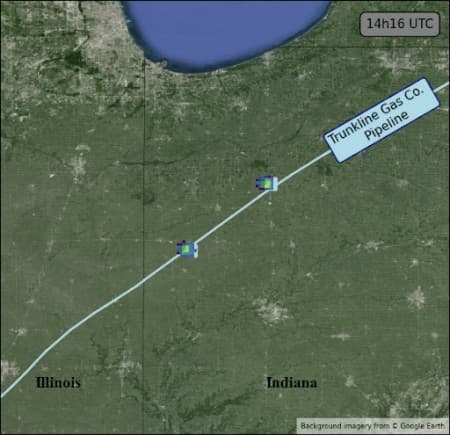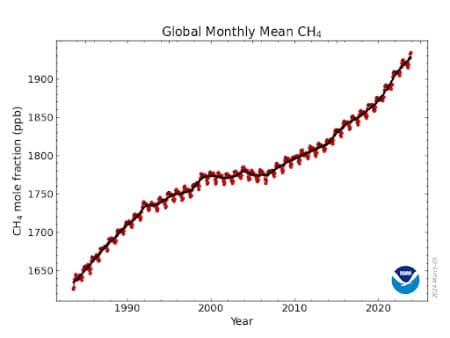For decades, scientists have come up with estimates of greenhouse gas emission through paper-based calculations of what’s pouring out of smokestacks and tailpipes, as well as based on the amount of energy consumed by end users.
Researchers also use data from satellites in low-Earth orbit to snap images of methane leaks as they circumnavigate the globe; unfortunately, these space objects typically zoom by at hypersonic speeds of ~17,000 miles per hour, meaning that scientists are only able to estimate emission rates.
Now, scientists have devised a method to more accurately estimate methane emissions using stationary weather satellites orbiting far above the planet’s surface. Last year, researchers at Harvard University discovered that the National Oceanic and Atmospheric Administration's Geostationary Operational Environmental Satellites (GOES) used for weather forecasts can be used to detect large methane emissions of around tens of metric tons an hour or larger. Methane is considered one of the most potent greenhouse gases.
Unlike their faster Low Earth Orbit (LEO) brethren, Geostationary or Geosynchronous Orbit (GEO/GSO) satellites orbit 22,200 miles above the surface of the Earth and maintain a fixed position relative to specific locations on the Earth's surface. Although the GOES system wasn't built to detect methane, its short-wave infrared sensors designed to observe things like snow cover and fire hot spots can also be used to detect methane leaks.
"GOES can detect brief releases that the other satellites miss, and it can trace detached plumes back to their sources. It can also quantify total release mass and duration, rather than just instantaneous estimates of emission rate," Daniel Varon, a research associate at Harvard University's Atmospheric Chemistry Modeling Group, has said. Related: Shadow Fleet Tanker Destined To Carry Sanctioned Russian Oil Causes Collision
The GOES system has already been tested in real-life: Last year, environmental intelligence firm Kayrros SAS used GOES to quantify that a gas pipeline by the Williams Companies Inc. (NYSE:WMB) spewed about 840 metric tons of methane into the atmosphere after a farmer in Idaho accidentally ruptured it while using an excavator. That’s close to the 50.9 million cubic feet, or 900 metric tons of methane, that the gas operator released as the official figure. Although the leak lasted for little more than an hour, the short-term climate impact of the event is roughly equal to the annual emissions from 17,000 U.S. cars.
Methane observations from the GOES satellite system

Source: Bloomberg
Mean Atmospheric Methane Abundance (Parts Per Billion)

Source: Global Monitoring Laboratory
Methane And Global Warming
The Global Monitoring Laboratory estimates methane concentration in the Earth’s atmosphere at 1,934 parts per billion (ppb), roughly equivalent to two cups of water inside a standard Olympic-size swimming pool.
In contrast, the current global average concentration of carbon dioxide (CO2) in the atmosphere is 421 parts per million (ppm), making it more than 200x more abundant than methane. However, methane is a far more potent greenhouse gas, more than 80x more powerful at warming the earth than CO2 over 20 years and 28x more powerful on a 100-year timescale.
Methane typically lasts only about a decade before it’s cycled out--a blip compared to the centuries that a CO2 molecule can last. Unfortunately, methane is constantly regenerated through multiple sources. Indeed, methane levels have increased sharply over the past four decades, and the gas is now responsible for about one-sixth of the total energy imbalance that is causing global warming.
Human activities contribute the majority of new methane emissions every year, with the energy sector contributing ~25% of the world’s methane emissions. Leaky gas infrastructure has emerged as a major pollutant.
Three years ago, satellites by the European Space Agency detected huge plumes of methane leaking from Gazprom’s 2,607-mile-long Yamal pipeline that transports natural gas from Siberia to Europe. Kayrros estimated that a single leak was spewing out a staggering 93 tonnes of methane every hour, equal to the amount of CO2 emitted by 15,000 cars in the U.S. in a whole year, while a second leak on the same pipeline was gushing 17 tonnes of the colorless and odorless gas every hour.
Last year, a study published in Nature Energy revealed that the U.S. Oil Patch is home to tens of thousands of inactive and unplugged offshore oil and gas wells, posing the risk of possible methane leaks into the ocean. In fact, there are more inactive and unplugged non-producing wells in the Gulf of Mexico coastal waters in Louisiana, Texas and Alabama than currently active wells. The study estimates that plugging and abandoning these wells would cost the industry a hefty $30 billion.
It also means that companies operating in the region risk clashing with environmental regulators, especially given that GOES can accurately detect and measure methane leaks.
Last year, the U.S. pipeline regulator unveiled new rules aimed at lowering methane leaks from the vast network of 2.7 million miles of natural gas pipelines in the country.
The proposal issued by the Transportation Department's Pipeline and Hazardous Materials Safety Administration could "significantly improve the detection and repair of leaks from gas pipelines... deploy pipeline workers across the country to keep more product in the pipe, and prevent dangerous accidents." According to the agency, the new rules could potentially eliminate 1 million metric tons of methane emissions by 2030, the equivalent of emissions from 5.6 million cars.
By Alex Kimani for Oilprice.com
More Top Reads From Oilprice.com:
- Hot Inflation Data Raises Stakes for Tomorrow’s Fed Meeting
- Steel Prices Stall As European Economies Slow
- Breakthrough Catalyst Turns Sewage Into Clean Energy



















Why is this author not talking about this man made the biggest environmental disaster caused by the U.S? All in name of the world hegemony, power and politics to weaken Russia, and to open the best business opportunities for the U.S LNG shipping to Europe at 4X the price of Russian gas. This really shows the real hypocrisy of the ENVIRO'S and GREENIES cults. After this act of EPIC environmental disaster, there was no protests on the streets, Greta Thunberg and her followers were MIA. The King Charles III, Al Gore and the UN's Czar Antonio Guterres did not care about it either. This really shows, that this whole thing called climate change is the biggest scam perpetrated in the history of mankind.
On the other NOTE , the more CO2 the better. CO2 is the gas of life necessary for human and plant life. According to normal scientists about 800 ppm would be better for the planet Earth then the current 421 ppm.